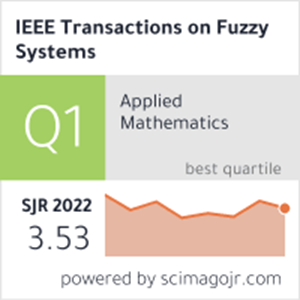Robust Classification via Interval Type-2 Fuzzy C-Means and Gradient Boosting
IF 11.9
1区 计算机科学
Q1 COMPUTER SCIENCE, ARTIFICIAL INTELLIGENCE
引用次数: 0
Abstract
This article introduces the Bayesian probabilistic fuzzy neural network (BPFNN), designed to overcome the limitations of Fuzzy C-Means (FCM) clustering, which struggles with uncertainty, noise, nonlinearity, and interpretability. Additionally, it addresses the shortcomings of traditional objective functions, such as mean squared error (MSE), which fail to capture the complexities inherent in high-dimensional and uncertain datasets. The BPFNN framework integrates Bayesian probabilistic modeling with advanced fuzzy clustering techniques, utilizing a non-Gaussian probability density function to better represent data uncertainties. A hybrid Markov chain Monte Carlo strategy, combining Metropolis-Hastings for membership updates and Gibbs sampling for cluster parameter estimation, is employed to effectively model uncertainty. For the learning of connection weights, the generalized cross-entropy loss function is applied, and the iteratively reweighted least squares algorithm is used to update the weights, allowing for a more precise quantification of the divergence between predicted and ground truth labels. Experimental evaluations on several benchmark datasets, as well as a high-dimensional laser-induced breakdown spectroscopy (LIBS) spectral dataset, demonstrate that the proposed BPFNN significantly outperforms both traditional methods and State-of-the-Art techniques in terms of classification accuracy and robustness. Notably, BPFNN achieves an average accuracy improvement of 3.2% over conventional models on benchmark datasets, with a 5.3% improvement on the LIBS dataset, highlighting its substantial advancement in the field.区间2型模糊c均值和梯度增强鲁棒分类
本文介绍了贝叶斯概率模糊神经网络(BPFNN),旨在克服模糊c均值(FCM)聚类的局限性,该聚类与不确定性,噪声,非线性和可解释性作斗争。此外,它还解决了传统目标函数(如均方误差(MSE))的缺点,这些缺点无法捕捉高维和不确定数据集固有的复杂性。BPFNN框架将贝叶斯概率建模与先进的模糊聚类技术相结合,利用非高斯概率密度函数更好地表示数据的不确定性。采用一种混合马尔可夫链蒙特卡罗策略,结合Metropolis-Hastings进行隶属度更新和Gibbs抽样进行聚类参数估计,有效地对不确定性进行建模。对于连接权重的学习,应用了广义交叉熵损失函数,并使用迭代重加权最小二乘算法来更新权重,从而可以更精确地量化预测和真实标签之间的差异。在几个基准数据集以及高维激光诱导击穿光谱(LIBS)光谱数据集上的实验评估表明,所提出的BPFNN在分类精度和鲁棒性方面明显优于传统方法和最新技术。值得注意的是,BPFNN在基准数据集上的平均准确率比传统模型提高了3.2%,在LIBS数据集上提高了5.3%,突出了其在该领域的实质性进步。
本文章由计算机程序翻译,如有差异,请以英文原文为准。
求助全文
约1分钟内获得全文
求助全文
来源期刊

IEEE Transactions on Fuzzy Systems
工程技术-工程:电子与电气
CiteScore
20.50
自引率
13.40%
发文量
517
审稿时长
3.0 months
期刊介绍:
The IEEE Transactions on Fuzzy Systems is a scholarly journal that focuses on the theory, design, and application of fuzzy systems. It aims to publish high-quality technical papers that contribute significant technical knowledge and exploratory developments in the field of fuzzy systems. The journal particularly emphasizes engineering systems and scientific applications. In addition to research articles, the Transactions also includes a letters section featuring current information, comments, and rebuttals related to published papers.
 求助内容:
求助内容: 应助结果提醒方式:
应助结果提醒方式:


